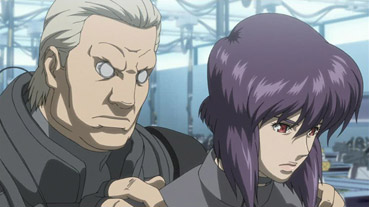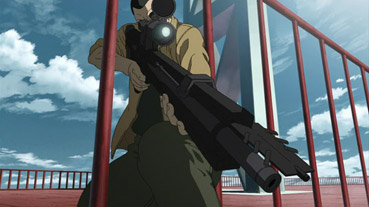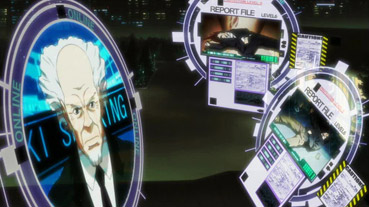|
The
exhaustingly titled Ghost in the Shell: Stand Alone
Complex Solid State Society is the third film in
the respected Ghost in the Shell series,
which was initiated by Mamoru Oshii's original 1995 Ghost
in the Shell and its 2004 sequel, Ghost
in the Shell 2: Innocence. The TV series spin-off
Ghost in the Shell: Stand Alone Complex kicked off in 2002, two years before Oshii's own sequel
hit Japanese cinemas. Solid State Society
is the latest episode in the franchise, a theatrical feature
that plays largely like an extended episode of the TV series,
whose narrative threads it incorporates and whose characters,
structure and style it retains. For fans of Stand
Alone Complex, and there are many, this is all
good news, as the larger budget and longer running time
allow for a more detailed and uninterrupted story and slicker
visuals and animation than the series allowed. For those
of us looking for a film that recaptures the beauty and
complexity of Innocence there is
less to celebrate.
The
original Ghost in the Shell was a genuinely
innovative and exciting anime feature, something that is harder to retrospectively appreciate due to the number
of films and series that it has directly influenced (the
recent anime series Ergo Proxy
is just one of many). Its sequel, Innocence,
was a challengingly complex work of astonishing visual and
aural beauty, one that expanded concepts explored
in the first film into the realms of the metaphysical. The
cult that built up around both films was not cast iron –
each divided opinion even within the anime fandom and continue
to do so, something visionary director Oshii Mamoru has
doubtless become familiar with (his 1991 live action film Avalon proved similarly divisive).

Stand
Alone Complex took the situations and characters
of Ghost in the Shell and from them fashioned
a futuristic cop show built around the investigations of
Section 9, the elite security force at the centre of both
films, and particularly the cybernetically enhanced characters
of Major Motoko Kusanagi and her long-standing friend Batou.
The technology and many of the themes of the series are
borrowed from the first feature and have become well worn
with the passing of time. The key strength of Stand
Alone Complex is its sociopolitical subtext,
its speculation of possible future directions for issues
of present concern.
Although
built around a self-contained story, Solid State
Society does assume some knowledge of the characters
and background from Stand Alone Complex.
It's been two years since Major Motoko left Section 9, which
has now substantially expanded and has Togusa as it's head
man. The unit's latest investigation centres around the
mass abduction of children and a string of mysterious suicides
by members of the disbanded Siak Republic. Former Siak Colonel
Ka Gae-Ru is one of them, taking a hostage and then shooting
himself, seemingly terrified by someone he calls The Puppeteer.
Pursuing a lead, Batou is unexpectedly re-united with Motoko,
who warns him to stay away from something called The Solid
State Society. Batou keeps their meeting a secret from his
colleagues, but can't shake the suspicion that Motoko may actually be the Puppeteer.
The
budget increase on Solid State Society over
its TV counterpart is signalled by the early swooping shot
of Motoko, perched Batman-like high above the city
and contemplating her next move. We're still a long way
short of the visual heights climbed by Innocence
here, but given that Oshii had a budget of something like
seven times what director Kamiyama Kenji had to work with,
this is not completely surprising. The expected mix of cell
animation with GC work is present, but Oshii's striking
placement 2D characters within detailed 3D CG environments
is rejected in favour of closer integration of the two,
with the fast moving Nissan cars coming across as the favourite
job of the 3D animators.
Solid
State Society tells a well devised and reasonably
complex story at a breezy pace, and as an addition to the
Stand Alone Complex world it delivers in the manner of some of the better
multi-episode threads of the series. But as a Ghost in the Shell
movie it's walking in some pretty large footprints. Both
the original film and its sequel were visionary works that
genuinely broke new ground, something Solid State
Society simply does not do. There's little here
that series fans won't have seen before, the concept of
a master hacker hooking into the cyberbrains of citizens
harking back to the first film – the hackers even have almost
identical names – while the later conspiratorial revelations
will likely prove old news for genre diehards. There's plenty
of action, but anime gunfights are never going to rival
those of top-flight live action films, and the undeniably
cool technology has not really advanced much from the series'
early days.

The
film still has its memorable moments, the neatest occurring
at the climax of a sequence in which Batou and Saito chase
down a sniper, and the bullets of two opposing gunmen who
have fired simultaneously at each other almost collide in
mid flight. There are also a couple of nice surprises within
the confines of the expected – from the moment Batou and
Motoko meet you just know she'll be back on the team eventually
despite Batou's suspicions, but her reappearance is nonetheless perfectly timed. As with the series,
it's the sociopolitical elements that give the story it's
substance, with current Japanese concerns over a declining
birth rate and an ageing population effectively incorporated,
although the repeated suggestion that the issue of increasing privacy invasion through the use of surveillance
cameras will be explored remains teasingly undeveloped.
But
for every aspect of the film I enjoyed there was another
that irritated. Stand Alone Complex fans
will probably delight at the juke-box variety of
Kanno Yôko's music score, but I found the multi-genre rock and
pop cornucopia annoyingly distracting rather than complimentary
to the visuals, and there's not even a hint of the operatic
majesty that so distinguished Kawai Kenji's score for Innocence.
And at the risk of inflaming the passions of the devoted,
I groaned out loud at the resurrection of the Tachikomas,
robotic assistants with the voices of over-excited children
whom I always regarded as the Jar-Jar Binks of the Stand
Alone Complex world. At least they're not on screen
for long.
In
the end, Solid State Society delivered what
I was expecting, no more, no less. If you're a fan of the
Stand Alone Complex series then you'll
probably be well happy with this latest chapter, which despite
its graphical enhancements is essentially more of the same,
its story comprised of familiar elements but still
well enough told. But if Oshii is your man and you're hoping
for something as innovative as Ghost in the Shell
or as daring as Innocence then you're in
for a bit of a let-down. Despite its feature status, Solid
State Society is an extension of the TV series,
which for this viewer never successfully captured the complexity
and vision of Oshii's films and whose character interplay
always felt closer to standard TV drama or even soap opera
than the more complex and troubled relationships suggested
by its big screen cousins. There's nothing wrong with Solid
State Society, a professional and entertaining
enough job. What's missing, something its big screen predecessors
had in spades, is the magic.
The
anamorphically enhanced 1.78:1 transfer here is clean and
sharp, with very good colour reproduction. The slight movement
judders caused more by the animation style than any conversion
issues. Colours are distinct and there is no evidence of
digital blocking or banding on areas of single or similar
colour.

There
are a total of six soundtracks on offer, with both the original
Japanese and the English dub each available in Dolby 2.0
stereo, Dolby 5.1 surround and DTS 5.1 surround. It's the
usual story of surround track superiority, with the DTS
in particular having some serious wallop, announcing its
credentials from the opening shot and making good use of
the surrounds for background and specific sound effects.
It's all down to personal preference, of course, but I've
never cared for the voice work on the American dub of the
series – Batou in particular lacks the gravitas of the Japanese
original, and hard though it is to believe, the Tachikomas
are even more annoying as hyper-excitable American children.
Unlike
Manga's 2-disc release of Innocence, the
DTS track has been comfortably fitted onto disc 1, leaving
disc 2 free for the extras. One extra you will find on disc
1 is Storyboard Subtitles. When
activated, thumbnails of the appropriate storyboard frame
will appear at the bottom of the shots they relate to. They're
not there for every shot and are very similistic in design,
but some will find this of interest.
The
rest of the extras are on disc 2.
Anime
+ Car Design – Designing the Future Car (24:10)
A look at the unusual collaboration between the filmmakers
and the car manufacturer Nissan, who developed two concept
cars used in the film. It sounds a lot more exciting than
it actually is – imagine a corporate video that includes
interviews with the design team and customer and plenty
of shots of the product you're probably close to the mark.
The design process itself is of some interest, however.
This is a Japanese featurette with fixed English subtitles.
English
production Interview (9:29)
An amiable chat with some of those involved in the English
language version. ADR director Kevin Seymour comes across
as particularly likeable.
Making
of a Tachikoma Robot (17:06)
OK, I got a little twitchy at the prospect of this one,
which details the development of a walking and talking Tachikoma
robot as a promotional item for the film under the guidance
of Tomotaka Takahashi of Robo Garage. But this is absolutely
worth watching for the demonstration of Takahashi's humanoid
'Chroino' robot, whose extraordinarily lifelike movements
have dropped the jaws of everyone I've shown the sequence
to. As with the previous Japanese featurette, the captions
are subtitled as well as the dialogue.
Mitsuhisa
Ishikawa Interview (8:41)
A conversation with the founder of Production I.G., the company
behind the Stand Alone Complex series and
Solid State Society. He's a man of few words, but does provide some brief but useful background
to the series and the film. It's interesting to hear that
the future of the series depends largely on how the American
rather than Japanese audience react to Solid State
Society.
English
Trailer (1:52)
An unsubtle sell to a ready-made audience.
Japanese
Trailer (2:49)
A slightly better and more detailed sell, free of English subtitles.
Uchikomastic
Days English (4:46)
Oh...my...God. A nightmarish, Sesame Street-style take
on The Ugly Duckling featuring baby Tachikomas
that had me sinking into my chair with wide-eyed horror.
It even has a song! By the end I was ready to kill everyone
within stabbing range.
Uchikomastic
Days Japanese (4:46)
The same horrible thing, only in Japanese.
World
Work File (30:29)
An extended featurette made to build up anticipation for
the Japanese release of Solid State Society. Actually a rather good introduction to the Ghost
in the Shell Universe, the main characters and
the film itself, it includes interviews with several of
the production staff but enough extracts and plot info to
act as a serious spoiler if you're planning to watch this
just before the movie.
It's
an easy choice. If you're a fan of Stand Alone Complex
then Solid State Society comes recommended,
but if you're not then you'll find nothing here to persuade
you to change your viewpoint. Manga's DVD release is a good
one, for the picture and sound and some of the extras, not
to mention the nice metal DVD case that may only be available
on the initial release, so grab it while you can. Me, I'm
forlornly waiting for Oshii's apparently brain-scrambling
Amazing Lives of the Fast Food Grifters
(Tachiguichi retsuden) to make it to UK
shores.
|